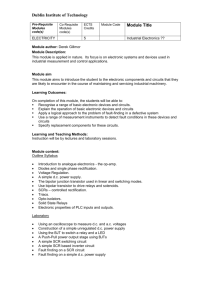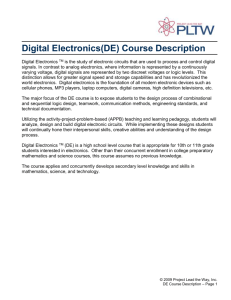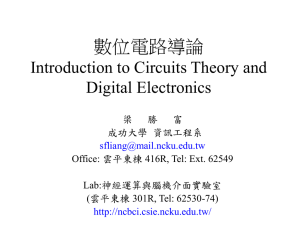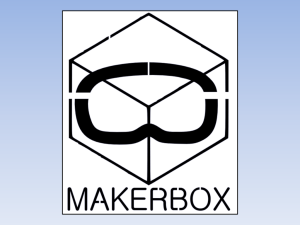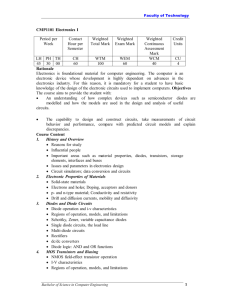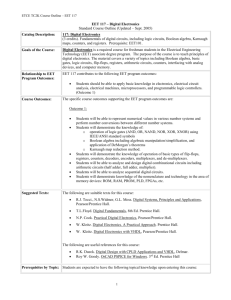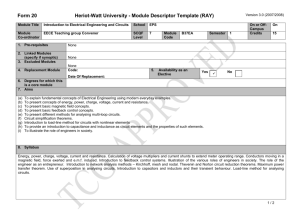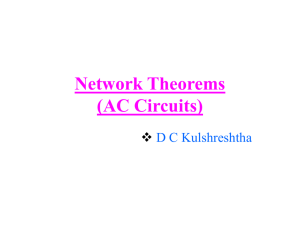Oregon Institute of Technology Wilsonville Campus STEM HST
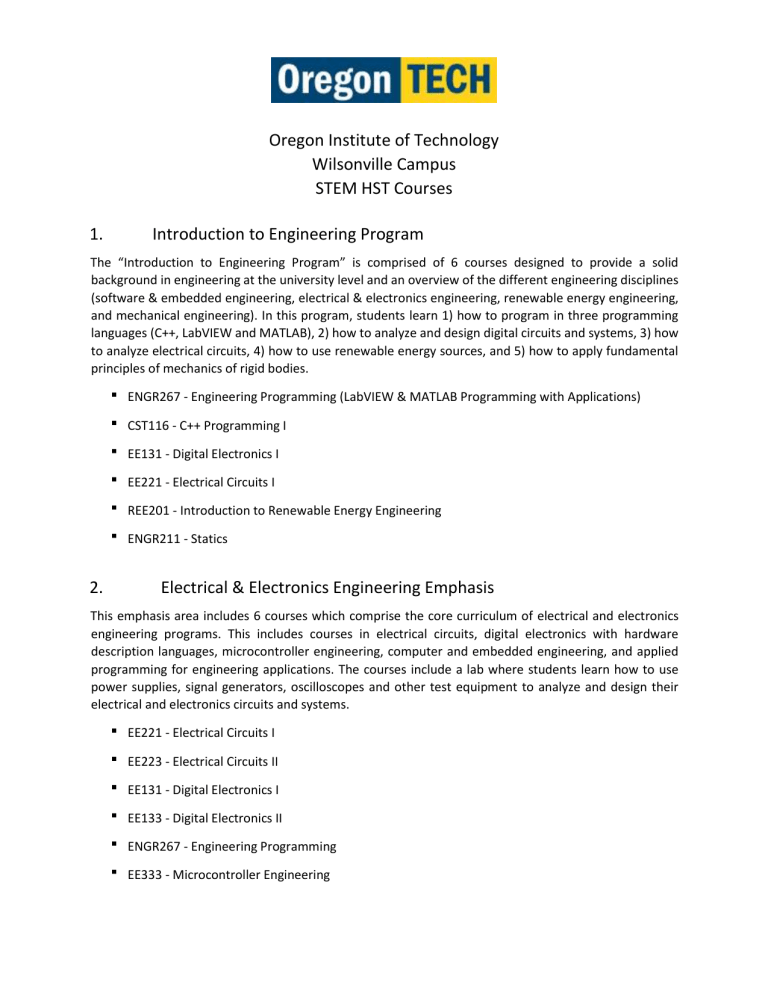
Oregon Institute of Technology
Wilsonville Campus
STEM HST Courses
1. Introduction to Engineering Program
The “Introduction to Engineering Program” is comprised of 6 courses designed to provide a solid background in engineering at the university level and an overview of the different engineering disciplines
(software & embedded engineering, electrical & electronics engineering, renewable energy engineering, and mechanical engineering). In this program, students learn 1) how to program in three programming languages (C++, LabVIEW and MATLAB), 2) how to analyze and design digital circuits and systems, 3) how to analyze electrical circuits, 4) how to use renewable energy sources, and 5) how to apply fundamental principles of mechanics of rigid bodies.
ENGR267 - Engineering Programming (LabVIEW & MATLAB Programming with Applications)
CST116 - C++ Programming I
EE131 - Digital Electronics I
EE221 - Electrical Circuits I
REE201 - Introduction to Renewable Energy Engineering
ENGR211 - Statics
2. Electrical & Electronics Engineering Emphasis
This emphasis area includes 6 courses which comprise the core curriculum of electrical and electronics engineering programs. This includes courses in electrical circuits, digital electronics with hardware description languages, microcontroller engineering, computer and embedded engineering, and applied programming for engineering applications. The courses include a lab where students learn how to use power supplies, signal generators, oscilloscopes and other test equipment to analyze and design their electrical and electronics circuits and systems.
EE221 - Electrical Circuits I
EE223 - Electrical Circuits II
EE131 - Digital Electronics I
EE133 - Digital Electronics II
ENGR267 - Engineering Programming
EE333 - Microcontroller Engineering
3.
Programming, Software, and Computer Systems Emphasis
This emphasis area is comprised of 5 courses which are core to the curriculum of the software and embedded systems engineering technology programs. This includes programing courses in C++, computer architecture, unix, and applied programming for engineering applications.
CST116 - C++ Programming I
CST126 - C++ Programming II
CST130 - Computer Organization
CST240 - UNIX
ENGR267 - Engineering Programming
4.
Renewable Energy Engineering Emphasis
This emphasis area is comprised of 5 courses which are part of core to the curriculum of the renewable energy engineering program. The program includes an introductory course (REE201) which provides an overview of all the renewable energy sources and the current state of the technology, as well core engineering courses in electrical engineering, electrical power, and applied programming. The courses include a lab where students learn how to use engineering equipment to solve practical problems.
REE201 - Introduction to Renewable Energy
EE221 - Electrical Circuits I
EE223 - Electrical Circuits II
REE243 - Electrical Power
ENGR267 - Engineering Programming
5.
Health Science & Technology Emphasis
This emphasis area includes the university level sequence in Anatomy & Physiology (with laboratory) which is a core requirement to all health science programs. Additionally, students get an overview of different health science programs by taking the respective introductory courses: MT103 - Introduction to
Medical Imaging (required for Diagnostic Medical Sonography, Nuclear Medicine Technology, Radiologic
Science, Echocardiography, and Vascular Technology), CLS100 - Introduction to Clinical Laboratory
Sciences, and EMS115 & EMS151/2. Students completing the EMS 151/152 courses can sit for the National
Registry examination to receive the Emergency Medical Technician (EMT) certification.
BIO 231,232,233 Anatomy & Physiology I, II, III (Required in all Health Programs)
MT103 Introduction to Medical Imaging (Required in all Medical Imaging Programs)
CLS100 Introduction to Clinical Laboratory Science
EMS115 Introduction to Emergency Medical Services (EMS)
EMS151,2 Emergency Medical Technician (EMT) I, II
6.
Mathematics & Science Emphasis
This emphasis area includes yearlong sequences in calculus, calculus-based physics, and chemistry. All engineering programs required these math and physics courses.
MATH: Calculus I, II, IV, Differential Equations
PHYSICS: Physics I, II, III
CHEMISTRY: Chemistry I
7.
College Level General Education Emphasis
This emphasis area includes the writing, speech, humanities, and social science courses that are core requirements to all bachelor degree programs at Oregon Tech.
Writing: WRI 121, WRI 122, WRI 227 (Argumentative Writing, Technical Writing)
Speech: SPE 111, SPE 321 (Fundamentals of Speech, Small Group & Team Communications)
Humanities (9 credits) & Social Science Courses (12 credits) - Selected based on student interest
For more information about Dual Credit and High School Transition Courses at Oregon Tech, contact:
Marla Edge, Director of Academic Agreements: marla.edge@oit.edu
Carleen Drago Starr, Dual Enrollment and Communication Coordinator in Wilsonville: carleen.drago@oit.edu
Or visit the OIT website: http://www.oit.edu/prospective-students/academic-agreements
